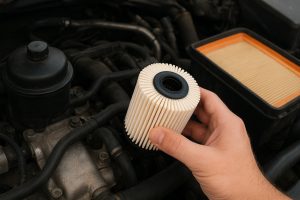When it comes to maintaining your engine’s health and longevity, choosing the right filter — whether oil, fuel or air — is much more than just picking the right size or brand. One of the key specifications you’ll encounter is the micron rating of the filter. This article explains what micron ratings mean, how they apply to engine filters, and how you can use them wisely to protect your powertrain.

What is a Micron Rating?
A micron (µm) is one millionth of a meter (0.000001 m) — in practical terms, it’s 0.001 mm. The concept of a micron rating in filtration refers to the largest size of particle that will (ideally) be removed by the filter under specified conditions.
In filtration parlance, the smaller the micron rating, the finer the filter media (i.e., the smaller particles it will stop).
However, there are important distinctions — namely nominal vs. absolute ratings, and how efficiency and flow are affected.
-
A nominal rating might say “10 µm” but only mean that it traps a certain percentage of 10 µm particles.
- An absolute rating aims to guarantee very high efficiency (typically 98 %+ of particles at or above the stated size are removed).
So when you see a filter rated “5 µm”, it’s essential to ask: 5 µm nominal? 5 µm absolute? At what efficiency percentage?
Why Micron Ratings Matter for Your Engine
Contaminants such as metal particles, soot, oxidised varnish or sludged oil all contribute to engine wear. A filter with an appropriate micron rating helps by removing particles before they cause abrasion or damage. Here’s how:
-
For engine oil filters, particles larger than bearing clearances can cause wear, scoring, or reduce oil life.
-
Filters rated for finer micron sizes remove smaller particles — but overly fine ratings can lead to reduced oil flow or premature bypass.
-
In real-world filter selection, there’s a balance: filtration efficiency + flow rate + capacity = optimal protection.
Here is a simplified table summarising typical micron rating ranges and their implications:
| Micron Rating | Typical Application | Pros | Cons |
|---|---|---|---|
| 25-40 µm | Standard full-flow oil filters | Good flow, adequate protection for many passenger engines | May allow smaller abrasive particles through |
| 10-20 µm | Higher-end full-flow oil filters | Better protection against smaller particles | Potentially higher bypass risk, shorter service intervals |
| <10 µm (e.g., 5-8 µm) | Ultra-fine or bypass filters / specialized systems | Excellent removal of very small particles | Very high clogging risk, restricted flow unless system designed for it |
Key Metrics and What to Ask
When evaluating filters for your engine, here are key metrics to pay attention to:
-
Micron rating (nominal vs absolute)
-
Ask: At what particle size is this rated — and what percentage of particles at that size are removed?
-
-
Capture efficiency / Beta ratio
-
The Beta ratio (βx) may say something like: “β10 = 8” (for every 8 particles entering, 1 passes downstream ~ 88% efficiency).
-
Full-flow oil filters may show something like 95% capture at 40 µm, but only 5% at 10 µm.
-
-
Dirt-holding capacity / service life
-
A finely rated filter might trap more, but clog sooner and cause bypass (i.e., unfiltered oil flow).
-
-
Flow rate / pressure-drop behaviour
-
If the filter is too restrictive due to fine media, oil flow suffers, which is just as bad as particles getting through.
-
Practical Advice for Engine Filter Selection

Here’s a list of practical tips when you’re choosing a filter for your vehicle:
-
Check what micron rating the filter manufacturer claims — and what the efficiency percentage is at that size.
-
Match the filter to the service conditions: dusty / dirty environments might require more frequent changes or more capable filters.
-
Don’t assume that a “lower micron number = always better” without considering flow and service interval trade-offs.
-
For everyday passenger vehicles, a good quality full-flow filter rated perhaps in the ~10-20 µm absolute range offers a solid balance. Filters rated much finer (<10 µm) may require changes more often or be better suited for specialised/industrial use.
-
Use good quality oil and follow recommended change intervals — even the best filter can only do so much if the oil is degraded or overloaded with contaminants.
-
Buying online? Ensure you are purchasing from reputable retailers and that the filter is the correct part for your engine.
If you’re looking to purchase filters, you can buy Filters online and ensure you select the correct specification for your engine.
Summary
Micron ratings are a central parameter in understanding how effective a filter is at stopping particles of a given size. But they don’t tell the whole story: how efficient the filter is at capturing those particles, how much debris it can hold, and how well it maintains flow under real-world conditions all matter. For your engine, picking the right filter means balancing filtration capability with the practical realities of oil flow, service interval and operating environment. By paying attention to micron ratings (and the related performance metrics) you can make an informed choice that helps keep your engine running clean, smoothly and reliably.
By understanding micron ratings and how they apply to engine filters, you’re better equipped to make smart decisions — whether you’re replacing the filter yourself or talking to your mechanic.